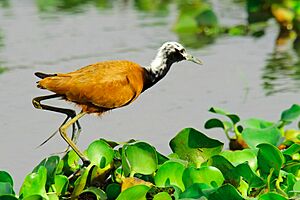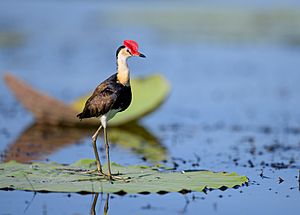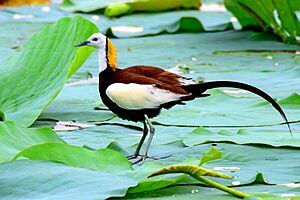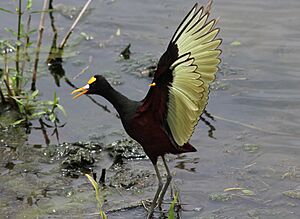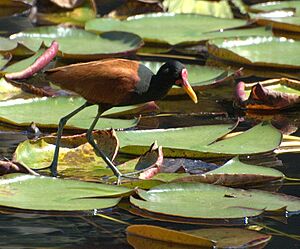Jacanidae facts for kids
Quick facts for kids JacanasTemporal range: Oligocene to recent
|
|
|---|---|
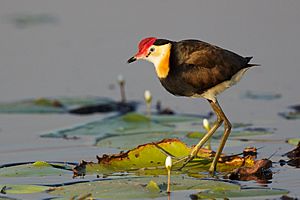 |
|
| Comb-crested jacana (Irediparra gallinacea) | |
| Scientific classification |
|
| Kingdom: | Animalia |
| Phylum: | Chordata |
| Class: | Aves |
| Order: | Charadriiformes |
| Suborder: | Thinocori |
| Family: | Jacanidae Chenu & des Murs, 1854 |
| Type genus | |
| Jacana |
|
| Genera | |
|
|
| Synonyms | |
|
Parridae |
|
Jacanas are amazing tropical birds, sometimes called "Jesus birds" or "lily trotters." They are known for their super long toes and claws. These special feet help them walk easily on floating plants in lakes and ponds. Jacanas live in warm, tropical parts of the world.
What's really cool about them is that the female birds are bigger than the males. In many jacana species, the female bird has several male partners. The male jacanas are the ones who build the nests, hatch the eggs, and take care of the baby chicks all by themselves.
Contents
All About Jacanas
Jacanas are a group of birds in the family called Jacanidae. French naturalists Jean-Charles Chenu and Marc des Murs first named this bird family in 1854. The name "jacana" comes from a Portuguese word, which came from an old Tupi name for the bird.
There are eight different types of jacanas alive today. Scientists have also found fossils of four jacana species that lived long ago. These fossils help us learn about their history.
How Jacanas Walk on Water
Jacanas are easy to spot because of their very long toes and claws. These special feet help them spread their weight out. This means they can walk on floating plants like lily pads without sinking! They live in shallow lakes and ponds.
Jacanas have sharp beaks and rounded wings. Some even have sharp spurs on their wings. Many species also have colorful skin flaps called wattles on their foreheads.
Jacana Families and Eggs
Female jacanas are usually larger than the males. But both sexes look similar in their feathers. Unlike many other birds, male jacanas are in charge of hatching the eggs and raising the chicks.
Most jacana species have more than one male partner (this is called polyandry). The only exception is the lesser jacana, which usually has one partner.
Jacanas build simple nests on floating plants. Their eggs have dark, wavy lines on them. This helps the eggs blend in with the water plants, keeping them safe. Male jacanas keep the eggs warm by holding them under their wings. Their wing bones are specially shaped to help with this.
Young jacana chicks can also hide under their parent's wings. The parent bird can even carry them to safety this way! If danger comes, young chicks can dive underwater. They stay submerged with only their beak sticking out to breathe. Some adult jacanas use this trick too.
What Jacanas Eat
Jacanas mainly eat insects and other small creatures. They pick these off floating plants or from the water's surface. They might also eat plant seeds. Some jacanas, like the wattled jacana, have even been seen picking ticks off large animals like capybaras! Sometimes, they might accidentally eat algae or plant bits while hunting for bugs.
How Jacanas Fly
Most jacanas have rounded wings and short tails. They tend to fly slowly and not very strongly. Most jacana species stay in one place. However, the pheasant-tailed jacana travels long distances. It migrates from the northern parts of its home to places like India and Southeast Asia.
Jacana Species Around the World
{{cladogram|align=right|caption=Family tree of living jacana types, based on their genes. |cladogram=
|
|||||||||||||||||||||||||||||||
| Species | Common name | Where they live | |
|---|---|---|---|
| Microparra capensis | Lesser jacana | Central and southeastern Africa | |
| Actophilornis africanus | African jacana | Central and southern Africa | |
| Actophilornis albinucha | Madagascar jacana | Madagascar | |
| Irediparra gallinacea | Comb-crested jacana | Malaysia, northeastern Australia | |
| Hydrophasianus chirurgus | Pheasant-tailed jacana | Asia | |
| Metopidius indicus | Bronze-winged jacana | Asia | |
| Jacana spinosa | Northern jacana | Mexico, Central America | |
| Jacana jacana | Wattled jacana | Panama, northeastern South America | |
| Extinct species | |||
| †Jacana farrandi | Pliocene, Florida | ||
| †Nupharanassa bulotorum | Lower Oligocene, Egypt | ||
| †Nupharanassa tolutaria | Lower Oligocene, Egypt | ||
| †Janipes nymphaeobates | Lower Oligocene, Egypt | ||
Images for kids




